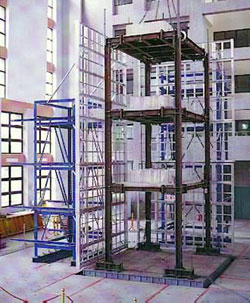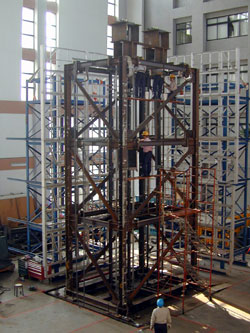Introduction to NCREE
Located on one of the most active seismic regions in the world,
Taiwan suffers from frequent earthquakes caused by the Circum Pacific Seismic
Belt. In fact, about twenty significantly strong earthquakes have been recorded
in the history of Taiwan. To compensate for this, earthquake hazard needs to
be taken into account in all civil engineering constructions to ensure sufficient
resistance against the shakes. The National Center for Research on Earthquake
Engineering (NCREE) was established in 1990. Since then, this institution has
worked endlessly to upgrade seismic resistant design standards for all constructions
and provides feedback to the engineering community through research and development.
It is hoped that through the coordinated activities of NCREE, the
enthusiasm to conduct high-quality research will be stimulated to bring out
the full potential of its participants. These activities will include the holding
of seminars and workshops on a regular basis in which knowledge can be advanced
and continually improved. In addition, special emphasis has been and will continually
be given to technology transfer to the engineering professions for enhanced
seismic-resistant designs.
Today, research in earthquake engineering has entered a new level
of interactive examinations between theory and experiment based on pure theory.
Secondly, seismic resistant design standards have been established to make research
results applicable in the engineering community. NCREE uses the prototype of
on-site experimental workstations along with integrated research projects, along
with the large simulation laboratory to perform related earthquake resistant
tests. It is the goal of the National Center for Research on Earthquake Engineering
to achieve breakthroughs on future research in the earthquake-engineering field.
Laboratory --
Tri-axial Seismic Shaking Table:
 The
seismic simulator in the NCREE possesses 6 degrees of freedom to simulate earthquake
motion in 3 axes. Major earthquakes occurred in the world can be reproduced
by the seismic simulator in the NCREE.The size of the shaking table of the seismic
simulator is 5m X 5M and its mass is 27tons. Structural model with maximum payload
50 tons can be accommodated on the table. The shaking table is a box shaped
structure so that high bending and torsional stiffness can be achieved with
limited mass of the table.
The
seismic simulator in the NCREE possesses 6 degrees of freedom to simulate earthquake
motion in 3 axes. Major earthquakes occurred in the world can be reproduced
by the seismic simulator in the NCREE.The size of the shaking table of the seismic
simulator is 5m X 5M and its mass is 27tons. Structural model with maximum payload
50 tons can be accommodated on the table. The shaking table is a box shaped
structure so that high bending and torsional stiffness can be achieved with
limited mass of the table.
 The
shaking table is driven by 12 hydraulic actuators 4 actuators for each axis.
The hydraulic power is provided by 2 electrical pumps and 3 diesel pumps which
offer a total flow rate of 1,235 gpm with a working pressure of 210kg/cm2, The
weight of the shaking table and the structural model is balanced by 4 static
supports.
The
shaking table is driven by 12 hydraulic actuators 4 actuators for each axis.
The hydraulic power is provided by 2 electrical pumps and 3 diesel pumps which
offer a total flow rate of 1,235 gpm with a working pressure of 210kg/cm2, The
weight of the shaking table and the structural model is balanced by 4 static
supports.
The reaction forces of the actuators are provided by the reaction
mass which is 16m (length) X 16(width) X 7.6m(height in dimension and about
4,000 tons in mass. In order to further improve the quality of the testing environment,
the reaction mass is isolated from the fixed foundation by 96 air springs and
80 dampers.
Reaction Wall & Strong Floor Testing System:
The reaction wall and strong floor provide the need for large-scale
structural and earthquake engineering experimental facilities. This intergraded
facility has the capability to perform large or full scale seismic tests by
using various experimental methods, such as traditional quasi-static tests,
cyclic loading tests and pseudodynamic tests.
 The
L-shaped reaction wall in this center adopts the cell type design with stepwise
arrangement of wall heights including 15m, 12m, 9m and 6m and the respective
wall width of 15.5m, 15.5m, 12m and 12m.The reaction wall consists of two 1.2m
thick reinforced and post-tensioned concrete plates, which are parallel at a
distance of 2.6m, and was enhanced with a 0.4m thick reinforces concrete plate
in between at an interval of 3m. The strong floor was designed as a reinforced
concrete slab which has a size of 60 x1.2m thick. The specified compressive
strength of the concrete for both the reaction wall and strong floor is 350
kg/cm2.
The
L-shaped reaction wall in this center adopts the cell type design with stepwise
arrangement of wall heights including 15m, 12m, 9m and 6m and the respective
wall width of 15.5m, 15.5m, 12m and 12m.The reaction wall consists of two 1.2m
thick reinforced and post-tensioned concrete plates, which are parallel at a
distance of 2.6m, and was enhanced with a 0.4m thick reinforces concrete plate
in between at an interval of 3m. The strong floor was designed as a reinforced
concrete slab which has a size of 60 x1.2m thick. The specified compressive
strength of the concrete for both the reaction wall and strong floor is 350
kg/cm2.
There are 18sets of static hydraulic actuators and 6 sets of dynamic
hydraulic actuators in this laboratory.  Their
detailed characteristics are listed in the table. Five hydraulic hard-line ports
are appropriately located in the reaction wall and strong floor. These ports
provide for a total of 1325 gpm hydraulic power supply and return as a drain
line. The working pressure for the hydraulic system is 210 kg/cm2.
Their
detailed characteristics are listed in the table. Five hydraulic hard-line ports
are appropriately located in the reaction wall and strong floor. These ports
provide for a total of 1325 gpm hydraulic power supply and return as a drain
line. The working pressure for the hydraulic system is 210 kg/cm2.

 The
seismic simulator in the NCREE possesses 6 degrees of freedom to simulate earthquake
motion in 3 axes. Major earthquakes occurred in the world can be reproduced
by the seismic simulator in the NCREE.The size of the shaking table of the seismic
simulator is 5m X 5M and its mass is 27tons. Structural model with maximum payload
50 tons can be accommodated on the table. The shaking table is a box shaped
structure so that high bending and torsional stiffness can be achieved with
limited mass of the table.
The
seismic simulator in the NCREE possesses 6 degrees of freedom to simulate earthquake
motion in 3 axes. Major earthquakes occurred in the world can be reproduced
by the seismic simulator in the NCREE.The size of the shaking table of the seismic
simulator is 5m X 5M and its mass is 27tons. Structural model with maximum payload
50 tons can be accommodated on the table. The shaking table is a box shaped
structure so that high bending and torsional stiffness can be achieved with
limited mass of the table. The
shaking table is driven by 12 hydraulic actuators 4 actuators for each axis.
The hydraulic power is provided by 2 electrical pumps and 3 diesel pumps which
offer a total flow rate of 1,235 gpm with a working pressure of 210kg/cm2, The
weight of the shaking table and the structural model is balanced by 4 static
supports.
The
shaking table is driven by 12 hydraulic actuators 4 actuators for each axis.
The hydraulic power is provided by 2 electrical pumps and 3 diesel pumps which
offer a total flow rate of 1,235 gpm with a working pressure of 210kg/cm2, The
weight of the shaking table and the structural model is balanced by 4 static
supports. The
L-shaped reaction wall in this center adopts the cell type design with stepwise
arrangement of wall heights including 15m, 12m, 9m and 6m and the respective
wall width of 15.5m, 15.5m, 12m and 12m.The reaction wall consists of two 1.2m
thick reinforced and post-tensioned concrete plates, which are parallel at a
distance of 2.6m, and was enhanced with a 0.4m thick reinforces concrete plate
in between at an interval of 3m. The strong floor was designed as a reinforced
concrete slab which has a size of 60 x1.2m thick. The specified compressive
strength of the concrete for both the reaction wall and strong floor is 350
kg/cm2.
The
L-shaped reaction wall in this center adopts the cell type design with stepwise
arrangement of wall heights including 15m, 12m, 9m and 6m and the respective
wall width of 15.5m, 15.5m, 12m and 12m.The reaction wall consists of two 1.2m
thick reinforced and post-tensioned concrete plates, which are parallel at a
distance of 2.6m, and was enhanced with a 0.4m thick reinforces concrete plate
in between at an interval of 3m. The strong floor was designed as a reinforced
concrete slab which has a size of 60 x1.2m thick. The specified compressive
strength of the concrete for both the reaction wall and strong floor is 350
kg/cm2. Their
detailed characteristics are listed in the table. Five hydraulic hard-line ports
are appropriately located in the reaction wall and strong floor. These ports
provide for a total of 1325 gpm hydraulic power supply and return as a drain
line. The working pressure for the hydraulic system is 210 kg/cm2.
Their
detailed characteristics are listed in the table. Five hydraulic hard-line ports
are appropriately located in the reaction wall and strong floor. These ports
provide for a total of 1325 gpm hydraulic power supply and return as a drain
line. The working pressure for the hydraulic system is 210 kg/cm2.